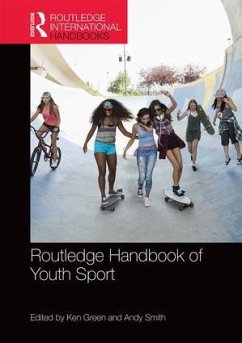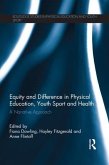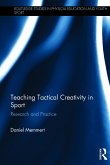Routledge Handbook of Youth Sport
Herausgeber: Green, Ken; Smith, Andy
Routledge Handbook of Youth Sport
Herausgeber: Green, Ken; Smith, Andy
- Gebundenes Buch
- Merkliste
- Auf die Merkliste
- Bewerten Bewerten
- Teilen
- Produkt teilen
- Produkterinnerung
- Produkterinnerung
Drawing on a wide diversity of disciplines, including sociology, psychology, policy studies, coaching, physical education and physiology, this comprehensive survey of young people's involvement in sport focuses on a key transitional period of our lives, from the later teenage years into the early twenties. Covering youth sport in all its forms and at all levels, from elite competition to leisure and school physical education, it also explores youth sport across the world, in developing and developed countries, and touches on some of the most significant themes in contemporary sport studies,…mehr
Andere Kunden interessierten sich auch für
![Routledge Handbook of Physical Education Pedagogies Routledge Handbook of Physical Education Pedagogies]() Routledge Handbook of Physical Education Pedagogies321,99 €
Routledge Handbook of Physical Education Pedagogies321,99 €![Defining Physical Education (Routledge Revivals) Defining Physical Education (Routledge Revivals)]() David KirkDefining Physical Education (Routledge Revivals)60,99 €
David KirkDefining Physical Education (Routledge Revivals)60,99 €![Defining Physical Education (Routledge Revivals) Defining Physical Education (Routledge Revivals)]() David KirkDefining Physical Education (Routledge Revivals)209,99 €
David KirkDefining Physical Education (Routledge Revivals)209,99 €![Equity and Difference in Physical Education, Youth Sport and Health Equity and Difference in Physical Education, Youth Sport and Health]() Equity and Difference in Physical Education, Youth Sport and Health190,99 €
Equity and Difference in Physical Education, Youth Sport and Health190,99 €![Equity and Difference in Physical Education, Youth Sport and Health Equity and Difference in Physical Education, Youth Sport and Health]() Equity and Difference in Physical Education, Youth Sport and Health73,99 €
Equity and Difference in Physical Education, Youth Sport and Health73,99 €![Research Methods in Physical Education and Youth Sport Research Methods in Physical Education and Youth Sport]() Research Methods in Physical Education and Youth Sport240,99 €
Research Methods in Physical Education and Youth Sport240,99 €![Teaching Tactical Creativity in Sport Teaching Tactical Creativity in Sport]() Daniel MemmertTeaching Tactical Creativity in Sport189,99 €
Daniel MemmertTeaching Tactical Creativity in Sport189,99 €-
-
-
Drawing on a wide diversity of disciplines, including sociology, psychology, policy studies, coaching, physical education and physiology, this comprehensive survey of young people's involvement in sport focuses on a key transitional period of our lives, from the later teenage years into the early twenties. Covering youth sport in all its forms and at all levels, from elite competition to leisure and school physical education, it also explores youth sport across the world, in developing and developed countries, and touches on some of the most significant themes in contemporary sport studies, including physical activity and health, lifelong participation, and talent development.
Produktdetails
- Produktdetails
- Verlag: Routledge
- Seitenzahl: 614
- Erscheinungstermin: 7. Januar 2016
- Englisch
- Abmessung: 260mm x 183mm x 37mm
- Gewicht: 1333g
- ISBN-13: 9780415840033
- ISBN-10: 0415840031
- Artikelnr.: 40333320
- Herstellerkennzeichnung
- Libri GmbH
- Europaallee 1
- 36244 Bad Hersfeld
- gpsr@libri.de
- Verlag: Routledge
- Seitenzahl: 614
- Erscheinungstermin: 7. Januar 2016
- Englisch
- Abmessung: 260mm x 183mm x 37mm
- Gewicht: 1333g
- ISBN-13: 9780415840033
- ISBN-10: 0415840031
- Artikelnr.: 40333320
- Herstellerkennzeichnung
- Libri GmbH
- Europaallee 1
- 36244 Bad Hersfeld
- gpsr@libri.de
Ken Green is Professor of Sociology of Physical Education and Youth Sport and Head of Sport and Exercise Sciences at the University of Chester, UK, as well as Visiting Professor at Hedmark University College, Norway, and the University of Wolverhampton, UK. He is Editor-in-Chief of the European Physical Education Review and his books include Understanding Physical Education (2008) and Key Themes in Youth Sport (2010). His main research interests revolve around physical education and youth sport. Andy Smith is Professor of Sport and Physical Activity at Edge Hill University, UK, where he is also Associate Head of the Department of Sport and Physical Activity. His research interests and publications focus on sport, physical activity and health and on youth, sport policy and development. He is co-author of Sport Policy and Development (with Daniel Bloyce, 2010), An Introduction to Drugs in Sport (with Ivan Waddington, 2009) and Disability, Sport and Society (with Nigel Thomas, 2009), and co-editor of Doing Real World Research in Sports Studies (with Ivan Waddington, 2014). Andy is also a former co-editor of the International Journal of Sport Policy and Politics, which he launched with Barrie Houlihan and Daniel Bloyce in 2009, and an Editorial Board member of Leisure Studies and the European Physical Education Review.
Introduction Section 1: Youth sport in context 1.1. Introduction 1.2. Young
people and social change 1.3. Youth leisure as the context for youth sport
1.4. Youths' use of time from comparative, historical and developmental
perspectives 1.5. Youth, sport and leisure careers Section 2: Youth sport
around the world 2.1. Introduction 2.2. Youth sport participation: a
comparison between European member states 2.3. Youth sport in Norway 2.4.
Youth sport in the United States 2.5. Youth sport in Australasia 2.6. Youth
sport in Japan 2.7. Youth sport in the Middle East 2.8. Youth sport in
China Section 3: Trends in youth sport 3.1. Introduction 3.2. Tracking and
youth sport: the quest for lifelong adherence to sport and physical
activity 3.3. Dropping out from clubs, dropping in to sport light?
Organizational settings for youth sports participation 3.4. Indoorising the
outdoors: Tempting young people's interests in lifestyle sports 3.5.
Lifestyle and adventure sports among youth Section 4: Socialisation and
youth sport 4.1. Introduction 4.2. Parenting and youth sport 4.3. Peer
group experiences in youth sport 4.4. Understanding take-up, drop-out and
drop-off in youth sport 4.5. A personal assets approach to youth sport
Section 5: Social divisions and youth sport 5.1. Introduction 5.2. Playing
an unequal game? Youth sport and social class 5.3. Sexuality, gender and
youth sport 5.4. Youth sport, 'race' and ethnicity 5.5. Sport, youth and
religion 5.6. Youth sport and dis/ability 5.7. Unpacking
gender/sexuality/disability/social class to understand the embodied
experiences of young people in contemporary physical culture 5.8. Youths'
participation rights in relation to dominant movement cultures Section 6:
Youth sport, physical activity and health 6.1. Introduction 6.2. Physical
activity and sedentary behaviour in youth 6.3. The health-enhancing effects
of physical activity among youth 6.4. Measuring physical activity among
youth 6.5. Youth sport, health and physical activity 6.6. Youth sport and
mental health 6.7. Eating disorders in young athletes 6.8. Everyday
distortions: youth sport and body images 6.9. Youth sport, cigarettes,
alcohol and illicit drugs Section 7: Elite youth sport 7.1. Introduction
7.2. The elements of talent development in youth sport 7.3. Talent
identification and development in youth sport 7.4. Health, well-being and
the 'logic' of elite youth sports work 7.5. Child abuse in sport: from
research to policy and prevention Section 8: Politics and policy in youth
sport 8.1. Introduction 8.2. Elite youth sport policy and dual career
support services in fifteen countries 8.3. Youth sport policy in small
states 8.4. Youth and sport-for-change programmes: what can you expect?
8.5. Enacting youth sport policy: towards a micro-political and emotional
understanding of community sports coaching work
people and social change 1.3. Youth leisure as the context for youth sport
1.4. Youths' use of time from comparative, historical and developmental
perspectives 1.5. Youth, sport and leisure careers Section 2: Youth sport
around the world 2.1. Introduction 2.2. Youth sport participation: a
comparison between European member states 2.3. Youth sport in Norway 2.4.
Youth sport in the United States 2.5. Youth sport in Australasia 2.6. Youth
sport in Japan 2.7. Youth sport in the Middle East 2.8. Youth sport in
China Section 3: Trends in youth sport 3.1. Introduction 3.2. Tracking and
youth sport: the quest for lifelong adherence to sport and physical
activity 3.3. Dropping out from clubs, dropping in to sport light?
Organizational settings for youth sports participation 3.4. Indoorising the
outdoors: Tempting young people's interests in lifestyle sports 3.5.
Lifestyle and adventure sports among youth Section 4: Socialisation and
youth sport 4.1. Introduction 4.2. Parenting and youth sport 4.3. Peer
group experiences in youth sport 4.4. Understanding take-up, drop-out and
drop-off in youth sport 4.5. A personal assets approach to youth sport
Section 5: Social divisions and youth sport 5.1. Introduction 5.2. Playing
an unequal game? Youth sport and social class 5.3. Sexuality, gender and
youth sport 5.4. Youth sport, 'race' and ethnicity 5.5. Sport, youth and
religion 5.6. Youth sport and dis/ability 5.7. Unpacking
gender/sexuality/disability/social class to understand the embodied
experiences of young people in contemporary physical culture 5.8. Youths'
participation rights in relation to dominant movement cultures Section 6:
Youth sport, physical activity and health 6.1. Introduction 6.2. Physical
activity and sedentary behaviour in youth 6.3. The health-enhancing effects
of physical activity among youth 6.4. Measuring physical activity among
youth 6.5. Youth sport, health and physical activity 6.6. Youth sport and
mental health 6.7. Eating disorders in young athletes 6.8. Everyday
distortions: youth sport and body images 6.9. Youth sport, cigarettes,
alcohol and illicit drugs Section 7: Elite youth sport 7.1. Introduction
7.2. The elements of talent development in youth sport 7.3. Talent
identification and development in youth sport 7.4. Health, well-being and
the 'logic' of elite youth sports work 7.5. Child abuse in sport: from
research to policy and prevention Section 8: Politics and policy in youth
sport 8.1. Introduction 8.2. Elite youth sport policy and dual career
support services in fifteen countries 8.3. Youth sport policy in small
states 8.4. Youth and sport-for-change programmes: what can you expect?
8.5. Enacting youth sport policy: towards a micro-political and emotional
understanding of community sports coaching work
Introduction Section 1: Youth sport in context 1.1. Introduction 1.2. Young
people and social change 1.3. Youth leisure as the context for youth sport
1.4. Youths' use of time from comparative, historical and developmental
perspectives 1.5. Youth, sport and leisure careers Section 2: Youth sport
around the world 2.1. Introduction 2.2. Youth sport participation: a
comparison between European member states 2.3. Youth sport in Norway 2.4.
Youth sport in the United States 2.5. Youth sport in Australasia 2.6. Youth
sport in Japan 2.7. Youth sport in the Middle East 2.8. Youth sport in
China Section 3: Trends in youth sport 3.1. Introduction 3.2. Tracking and
youth sport: the quest for lifelong adherence to sport and physical
activity 3.3. Dropping out from clubs, dropping in to sport light?
Organizational settings for youth sports participation 3.4. Indoorising the
outdoors: Tempting young people's interests in lifestyle sports 3.5.
Lifestyle and adventure sports among youth Section 4: Socialisation and
youth sport 4.1. Introduction 4.2. Parenting and youth sport 4.3. Peer
group experiences in youth sport 4.4. Understanding take-up, drop-out and
drop-off in youth sport 4.5. A personal assets approach to youth sport
Section 5: Social divisions and youth sport 5.1. Introduction 5.2. Playing
an unequal game? Youth sport and social class 5.3. Sexuality, gender and
youth sport 5.4. Youth sport, 'race' and ethnicity 5.5. Sport, youth and
religion 5.6. Youth sport and dis/ability 5.7. Unpacking
gender/sexuality/disability/social class to understand the embodied
experiences of young people in contemporary physical culture 5.8. Youths'
participation rights in relation to dominant movement cultures Section 6:
Youth sport, physical activity and health 6.1. Introduction 6.2. Physical
activity and sedentary behaviour in youth 6.3. The health-enhancing effects
of physical activity among youth 6.4. Measuring physical activity among
youth 6.5. Youth sport, health and physical activity 6.6. Youth sport and
mental health 6.7. Eating disorders in young athletes 6.8. Everyday
distortions: youth sport and body images 6.9. Youth sport, cigarettes,
alcohol and illicit drugs Section 7: Elite youth sport 7.1. Introduction
7.2. The elements of talent development in youth sport 7.3. Talent
identification and development in youth sport 7.4. Health, well-being and
the 'logic' of elite youth sports work 7.5. Child abuse in sport: from
research to policy and prevention Section 8: Politics and policy in youth
sport 8.1. Introduction 8.2. Elite youth sport policy and dual career
support services in fifteen countries 8.3. Youth sport policy in small
states 8.4. Youth and sport-for-change programmes: what can you expect?
8.5. Enacting youth sport policy: towards a micro-political and emotional
understanding of community sports coaching work
people and social change 1.3. Youth leisure as the context for youth sport
1.4. Youths' use of time from comparative, historical and developmental
perspectives 1.5. Youth, sport and leisure careers Section 2: Youth sport
around the world 2.1. Introduction 2.2. Youth sport participation: a
comparison between European member states 2.3. Youth sport in Norway 2.4.
Youth sport in the United States 2.5. Youth sport in Australasia 2.6. Youth
sport in Japan 2.7. Youth sport in the Middle East 2.8. Youth sport in
China Section 3: Trends in youth sport 3.1. Introduction 3.2. Tracking and
youth sport: the quest for lifelong adherence to sport and physical
activity 3.3. Dropping out from clubs, dropping in to sport light?
Organizational settings for youth sports participation 3.4. Indoorising the
outdoors: Tempting young people's interests in lifestyle sports 3.5.
Lifestyle and adventure sports among youth Section 4: Socialisation and
youth sport 4.1. Introduction 4.2. Parenting and youth sport 4.3. Peer
group experiences in youth sport 4.4. Understanding take-up, drop-out and
drop-off in youth sport 4.5. A personal assets approach to youth sport
Section 5: Social divisions and youth sport 5.1. Introduction 5.2. Playing
an unequal game? Youth sport and social class 5.3. Sexuality, gender and
youth sport 5.4. Youth sport, 'race' and ethnicity 5.5. Sport, youth and
religion 5.6. Youth sport and dis/ability 5.7. Unpacking
gender/sexuality/disability/social class to understand the embodied
experiences of young people in contemporary physical culture 5.8. Youths'
participation rights in relation to dominant movement cultures Section 6:
Youth sport, physical activity and health 6.1. Introduction 6.2. Physical
activity and sedentary behaviour in youth 6.3. The health-enhancing effects
of physical activity among youth 6.4. Measuring physical activity among
youth 6.5. Youth sport, health and physical activity 6.6. Youth sport and
mental health 6.7. Eating disorders in young athletes 6.8. Everyday
distortions: youth sport and body images 6.9. Youth sport, cigarettes,
alcohol and illicit drugs Section 7: Elite youth sport 7.1. Introduction
7.2. The elements of talent development in youth sport 7.3. Talent
identification and development in youth sport 7.4. Health, well-being and
the 'logic' of elite youth sports work 7.5. Child abuse in sport: from
research to policy and prevention Section 8: Politics and policy in youth
sport 8.1. Introduction 8.2. Elite youth sport policy and dual career
support services in fifteen countries 8.3. Youth sport policy in small
states 8.4. Youth and sport-for-change programmes: what can you expect?
8.5. Enacting youth sport policy: towards a micro-political and emotional
understanding of community sports coaching work









